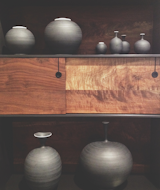Newer designs include a Brancusi-inspired wall vase (left), in which eight conical, cup-like segments have been joined. Kaiser's Stack Vase resembles an upright clay caterpillar in what he describes as a "deliberate kiln accident": The cavity is made from 13 bottomless bowls, which were made and glazed seperately but then fired in a stack and therefore fused together.
Kaiser's red cups are a study in contrasts between fluid bodies and textured bases, glossy and matte surfaces. The porcelain vessels were dipped in red slip and fired, changing in color to mottled pink. The interiors are glazed with glossy blue. His Kangen oribe cups employ the same oribe copper glaze, but each one reacts differently with colored engobes to produce very different shades, "especially when fired in strong reduction."
Austrian ceramist Matthias Kaiser experiments with a stunning range of experimental glazes for his pottery, while his sculptural influences range from traditional Japanese pottery to music: "I constantly think about shapes and surfaces, so any glimpse, thought or sound has the potential to germinate into an idea."
For his celadon-glazed Wayward vase series, Kaiser created and then joined two volumes, then carving deep grooves into the thicker bottom half. "With its eccentric chimney-like neck, the vessel conjures up the image of industrial architecture," Kaiser says. The tall vase comes with a shorter companion.
Friends from Tonko's hometown of Bregenz, Austria, commissioned the studio when they acquired some land next to their home. They use it for drawing and sketching, as well as creating clay and gypsum sculptures that are later cast into bronze. Since the area is close to where he grew up, Tonko was incredibly familar with the view from the hillside.
What the original building lacked in period detailing, it made up for with massive interior spaces, natural light, and a hardy palette of wood and raw brick.
Working with these loft signatures, David developed the hall’s liveable side, adding under-floor heating, and a gigantic kitchen on the upper floor running the width of the building, with a 37-foot-long solid walnut counter on top of stainless steel cabinets. This unites the dining, cooking and social spaces that run the length of the front façade on the upper floor.
A glass door on the north side sits opposite a glass window on the south wall that overlooks a birch tree forest. Skylights pull light into the interior. "Even though the artist paints landscapes, she didn't want to be distracted by the beauty of her surroundings while in the studio, which led to the limited apertures," Peterson says.
Ben Medansky
"As a kid, I would constantly play with silly putty to construct small abstract sculptures," Ben Medansky says. "I’ve always loved connecting with the earthy material of clay and been interested in making objects with my hands." Early explorations eventually led Medansky to study ceramics in high school and college; today he works from his L.A. studio creating functional pieces inspired by abstract forms.
The Vessels Medansky displayed were thrown on a wheel. He then applied more clay to the outside to create the 3-D surface textures. "I usually start by throwing a cylinder and adding or subtracting forms from there," he says. "Most of my pieces are inspired by certain movements and references found in modern art and architecture, such as Le Corbusier’s Notre Dame du Haut in Ronchamp, France. When glazing the objects, I like to use a satin white speckled glaze because it’s a color I see it fitting into domestic and exhibition spaces."
3,958 more photos



































